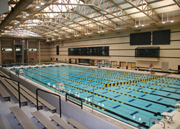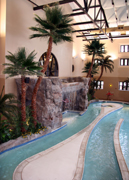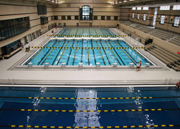Visitors at the new $49 million Rothwell-Brewer Student Recreation Center Complex are usually in awe of one of the nation's top five recreation projects and Missouri's largest aquatic complex.
But equally awesome is the behind-the-scenes energy savings a dream team of architects, consultants, and engineers built into the state-of-the-art project that will save University of Missouri millions of dollars in operating costs over the life of the center's dual natatoriums. The team consisted of consulting engineering firm McClure Engineering Associates, St. Louis; architect Hastings + Chivetta Architects Inc., St. Louis; commercial pool consultant Councilman/Hunsaker Associates, St. Louis; and mechanical contractor J. Louis Crum, Columbia, MO.
Instead of accepting just a conventional economizer to take advantage of approximately 1,500 hours of cooler outside air during the spring and fall seasons for example, McClure specified energy saving configurations in each of the five commercial dehumidifiers supplying the competition pool and leisure pool natatoriums. "We took a very active approach in saving energy throughout the facility, and we were able to make some of the most significant reductions with the specification of custom natatorium mechanical equipment,"



Esarey, who is one of the nation's most experienced indoor pool engineers, with over 15 McClure natatorium projects to his credit, had considered the installation savings associated with one large unit, but eventually decided to divide the dehumidification load into four units for better redundancy. Also, one large unit would have complicated the air distribution design, which is divided into zones supplied by each unit. Four units also allowed the ductwork size to stay below the 48-inch diameter threshold, which is a National Fire Protection Association (NFPA) code related to sprinkler system placement.
All air distribution is from ceiling-hung ductwork, because the preferred method of adding under-deck air distribution was physically impossible in both the Rothwell and Brewer building retrofits due to existing foundations.

Heat exchangers were also used as secondary or primary pool water heating for auxiliary vessels such as the club and competition warm-up spas.
To supplement the campus' central plant chilled water system, McClure also specified two 2,000-ton absorption chillers by McQuay, Minneapolis, MN, for the project. Throughout the gyms, offices, fitness rooms and other areas outside the natatoriums, McQuay air handlers and variable air volume (VAV) boxes supply heating and cooling.
McClure's design also saves significant energy while simultaneously providing air comfort to the 1,000-seat spectator section. The large 7,000-square-foot area uses a supplemental chilled water cooling coil in a Dectron unit that supplies cooler, dehumidified air to spectators via a single duct run. "Seating areas are typically treated with the same set points as the rest of the natatorium, which means an elevated area is receiving approximately 87ºF air, which is not comfortable for spectators,"